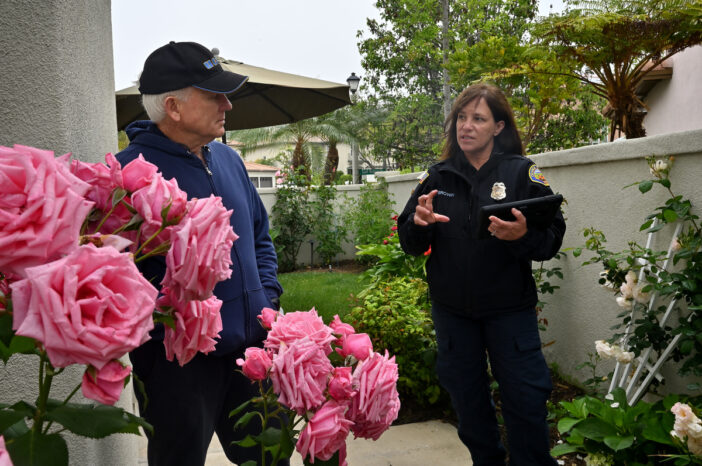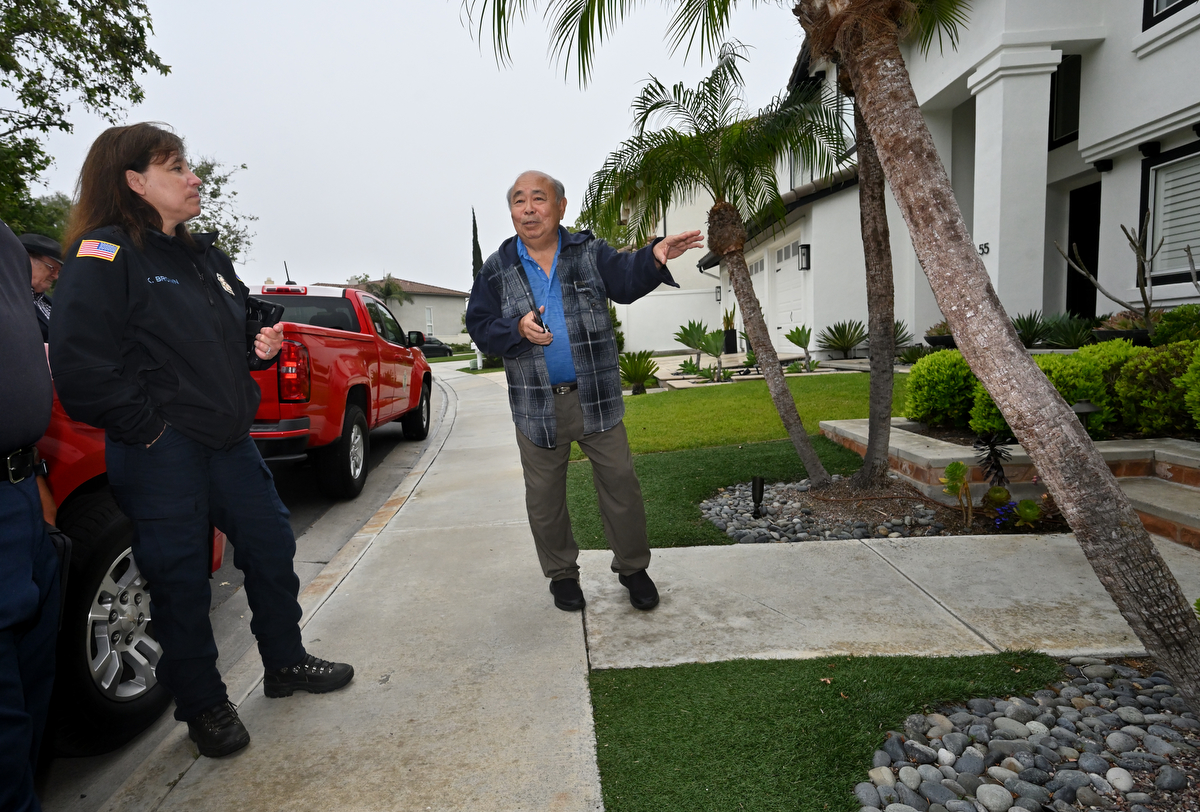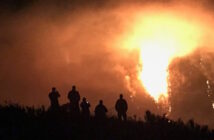Together they meticulously examine dormers, eaves, attic vents, siding, the roof, connections between fences and gutters and the house.
They review the landscaping, the types, height, and proximity of vegetation. Decks and patios get the once-over as well.
Kim Brown, Orange County Fire Authority (OCFA) Assistant Fire Marshal, scans everything with a practiced eye as she walks around the Rancho Santa Margarita home of Rich Keenan as part of a free Home Assessment consultation. OCFA offers in-person as well as online assessments. Tours last about 45 minutes and homeowners receive a detailed report showing how their homes and lots rate and areas in which they can improve.
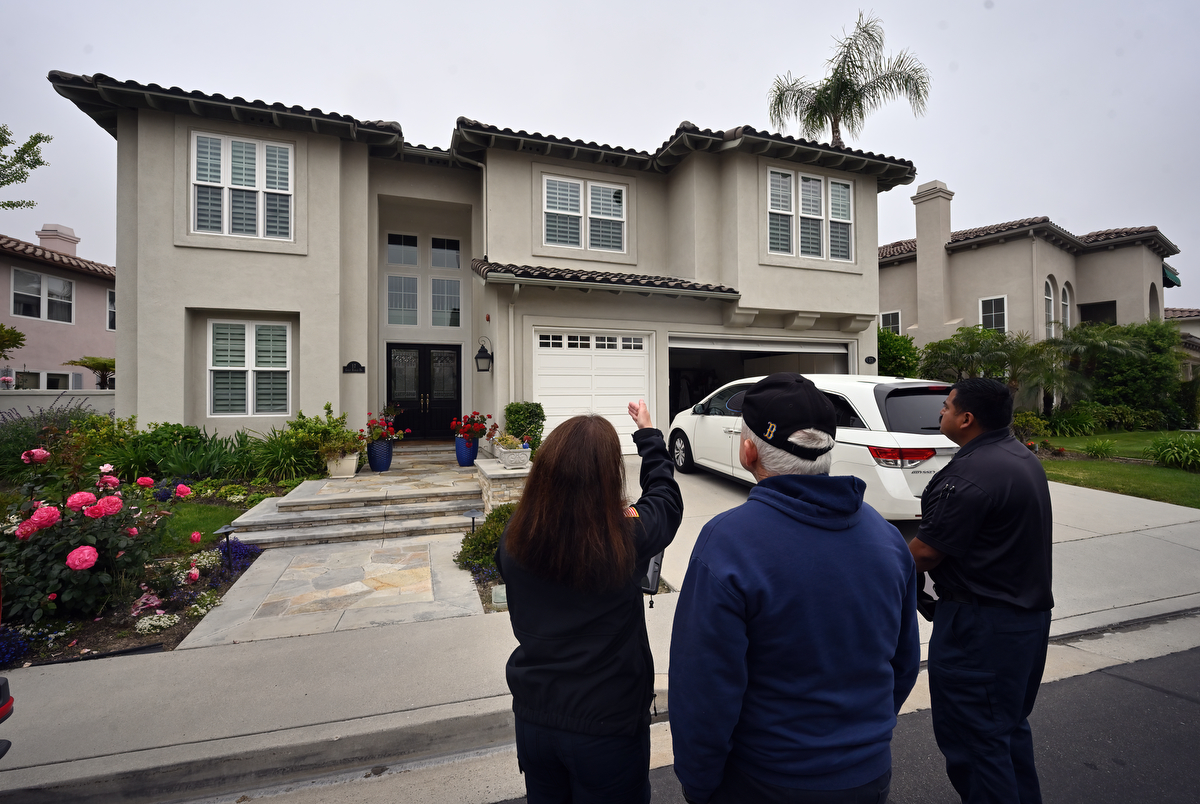
Assistant Fire Marshal Kim Brown, left, and Orange Country Fire Inspector Francisco Rivera, right, look over the plants growing near Rich Keenan’s home during a fire inspection.
Photo by Steven Georges/Behind the Badge
In fire-prone areas, like much of Orange County, residents can always improve their overall fire preparation. Public safety sites such as ReadyOC have specific sections on wildfires preparedness including clearing vegetation, identifying evacuation routes and having enough supplies in your household.
ReadyOC states, “According to Verisk’s 2019 Wildfire Risk Analysis 4.5 million U.S. homes were identified at high or extreme risk of wildfire. About 40 percent were in California.”
In the wake of an unusually wet winter of atmospheric rivers after a calm fire season, there is unprecedented undergrowth on hillsides, which translates into excessive fuel for fires. Earlier this year, State Farm announced it would not sell any new home insurance policies in California. With that announcement came a revelation by Allstate that it had quietly made the same decision last year, all of which underscores the importance of protecting homes from fire.
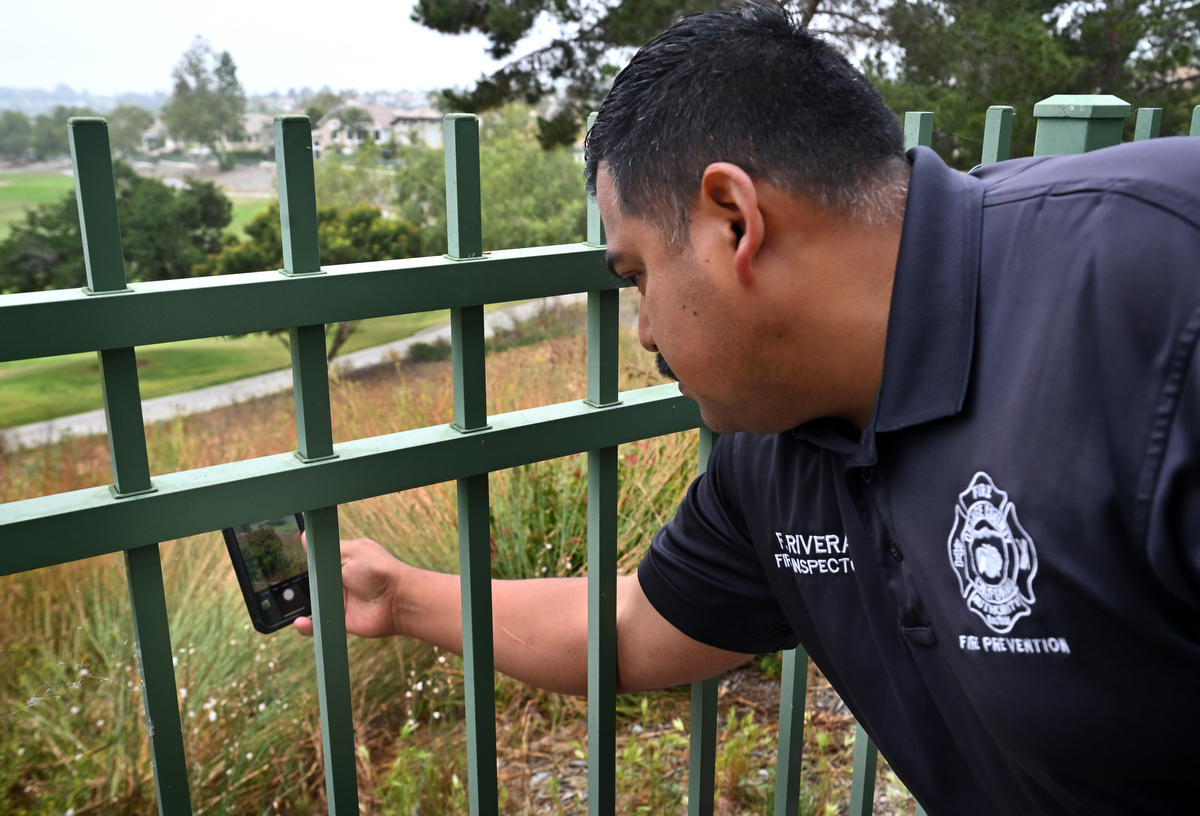
Orange Country Fire Inspector Francisco Rivera catalogs the type of plants growing in Rich Keenan’s backyard during fire season.
Photo by Steven Georges/Behind the Badge
Looking for vulnerabilities
Brown and Keenan examine the home for any place where flying fire embers could settle and grow. Each year embers, which can fly five miles ahead of advancing flames, destroy homes far from wildland areas.
In susceptible areas, the concern is particularly acute, such as in Keenan’s Dove Canyon neighborhood immediately south of Trabuco Canyon and southwest of where the 2018 Holy Fire torched more than 20,000 acres.
So, in the review, Brown addresses concerns big and small. There are myriad places where embers can embed unnoticed and cause massive problems.
“Firefighters don’t even know until they get inside,” Brown said.

Rich Keenan points out the trees and roof area of his two-story home to Assistant Fire Marshal Kim Brown during a fire inspection.
Photo by Steven Georges/Behind the Badge
Home hardening, with the use of flame-resistant building materials, reduces the chance of ignition from direct flame, firebrand showers, and radiant heat coming from outside of a defensible zone, according to OCFA.
Abutting Keenan’s property and the lush green fairway below is a hillside overgrown with two- to three-foot-tall onion weed, bougainvillea, and grasses. The hillside, which still retains hints of green from winter, is scheduled to be mowed by the property management company and Keenan is monitoring it closely.
“They’ll start drying up pretty soon,” Fire Inspector Franicisco Rivera said of the weeds, “that’s the risk.”
On his property, Keenan is advised to keep vegetation low, spaced apart and, preferably, away from the house. Keenan said his wife would not be pleased when she heard they would be removing vegetation to five feet from the home and replacing it with rocks.
Luckily for Keenan, although his house was built in 1994 and prior to a number of fire codes, his attention to detail and proactive measures to harden his home leads to a positive general review.
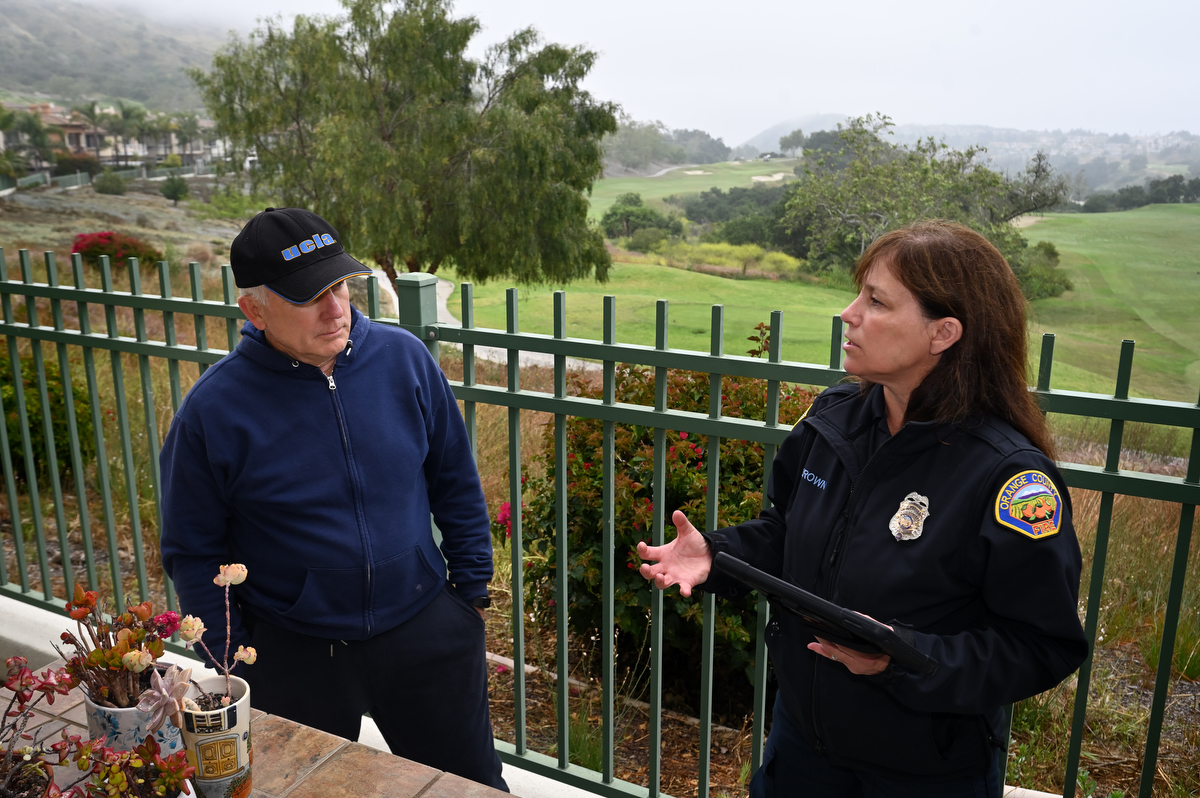
Assistant Fire Marshal Kim Brown looks at the backyard of Rich Keenan’s home and the brush area of Dove Canyon Golf Club’s course.
Photo by Steven Georges/Behind the Badge
Community-wide efforts needed
Keenan’s neighbor, Dennis Shoji, is a delegate of the Dove Canyon Homeowners Association. He has lobbied long and loud for greater attention to fire preparedness and safety as well as architectural and other guidelines to protect the neighborhood of $1.5 to $2 million homes.
Although other homeowners have been resistant, “We’re slowly building momentum,” Shoji said.
“It’s really good to see neighborhoods interested (in fire prevention),” Brown said.
As part of its mission to increase fire education, OCFA promotes its “Ready, Set, Go” initiative. The program advises residents to be:
- Ready, by taking personal responsibility and preparing long before the threat of a wildfire is imminent;
- Set, with a vehicle packed with an emergency kit, when the time approaches to leave and be aware of the latest news from local media and fire department; and
- Go, with an action plan and an evacuation route to allow firefighters to maneuver.

Assistant Fire Marshal Kim Brown goes over the plants growing in the front yard of Rich Keenan’s home.
Photo by Steven Georges/Behind the Badge
Community groups can request presentations from OCFA on fire and other safety and disaster preparedness issues. Brown also recommends residents sign up with Alert OC to receive immediate city and neighborhood-specific safety information in emergencies.
Preparedness is particularly important in vulnerable areas where housing and wildlands intersect, such as adjacent to Trabuco Canyon.
“There’s definitely potential,” Brown said of Keenan’s neighborhood being affected by fire. “It’s completely surrounded by wildlands.”
Fire season coming
Southern California’s unexpectedly wet winter brought a banner season with green hills and a profusion of wildflowers. But don’t be fooled. While the spring colors were beautiful in the short term, in the long term they mean something else to firefighters – fuel.
“These grasses will die and we know it will happen,” said Isaac Sanchez, Battalion Chief in Communications with Cal Fire.
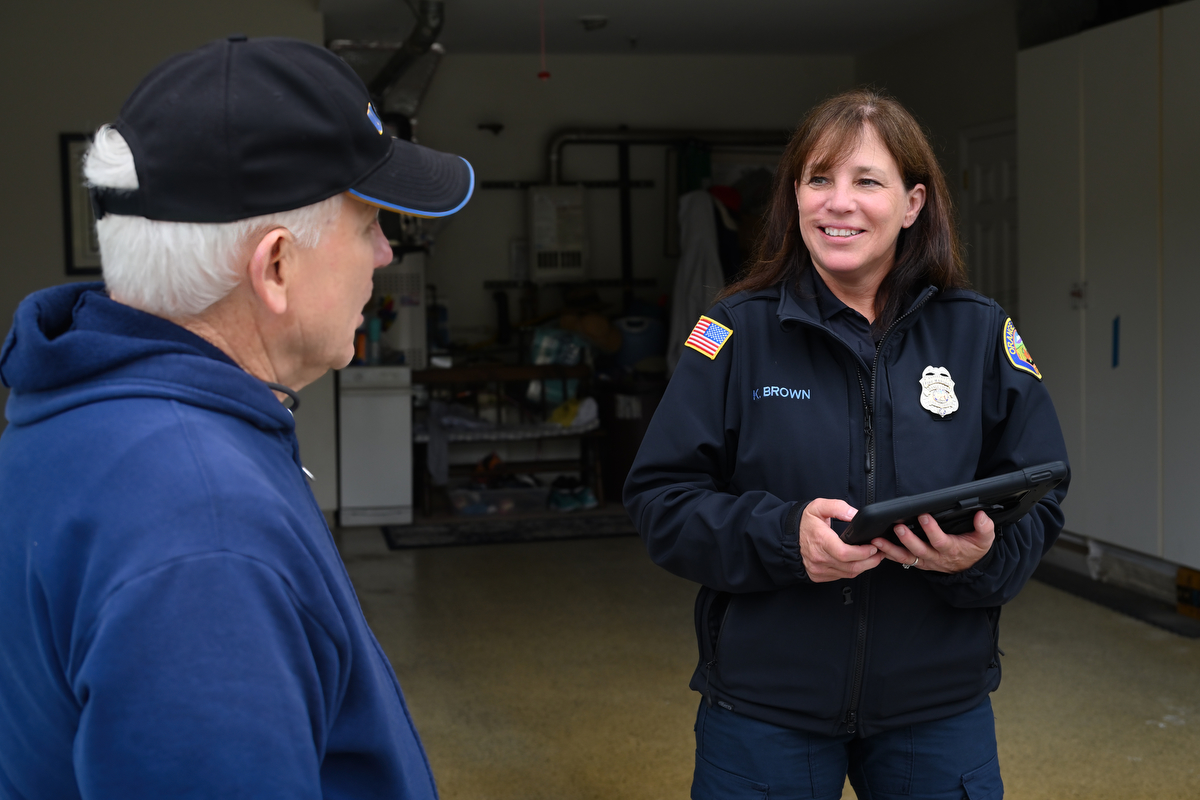
Rich Keenan talks about his house with OCFA’s Kim Brown, an assistant fire marshal, during a fire season inspection.
Photo by Steven Georges/Behind the Badge
And when that happens, he said, “It results in increased fuel loading in vegetation that has a short life cycle – grasses that bolster fire danger.”
That’s why, Sanchez says, “We have to expect the worst and then build our preparations around that.”
“We’re on the precipice of a big fire season every year,” Eric Knapp, a research ecologist with the U.S. Forest Service, told the San Francisco Standard.
For those on the edges of the wildlands, there is risk and reward.
As OCFA says, “Homes survive wildfires because of home hardening and vegetation management, not because of fate or luck.”
 Behind the Badge
Behind the Badge
